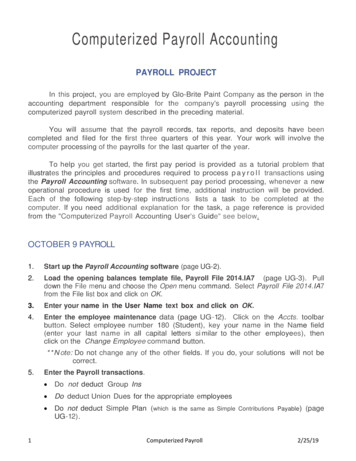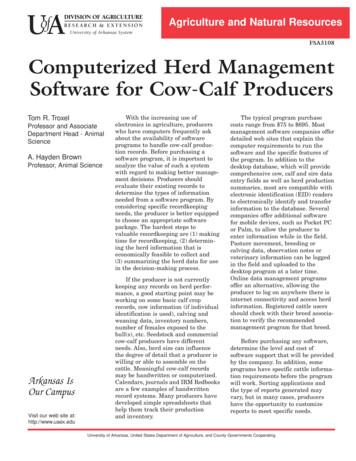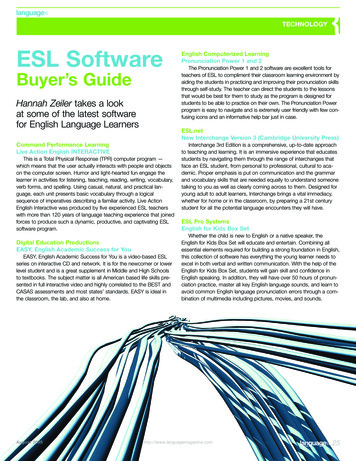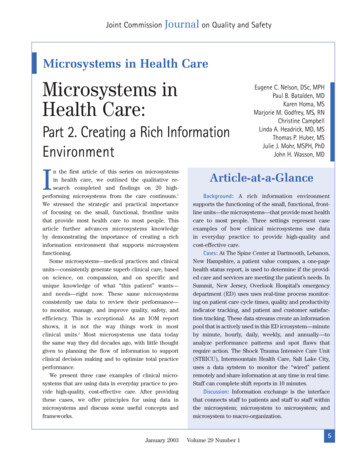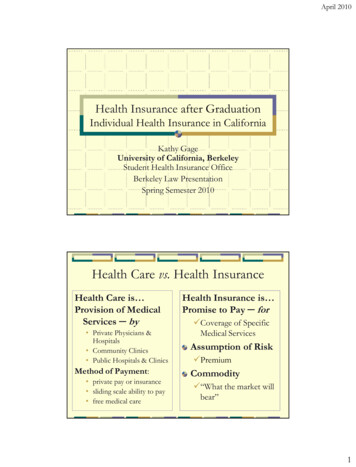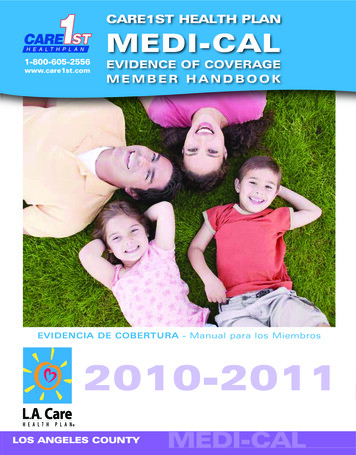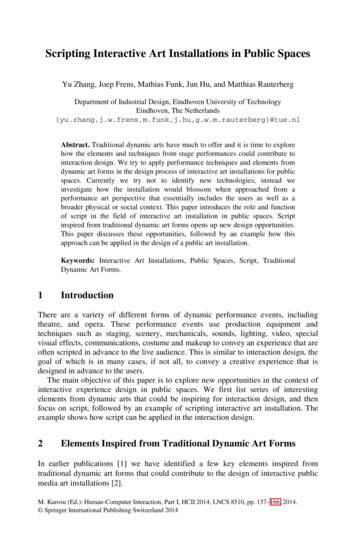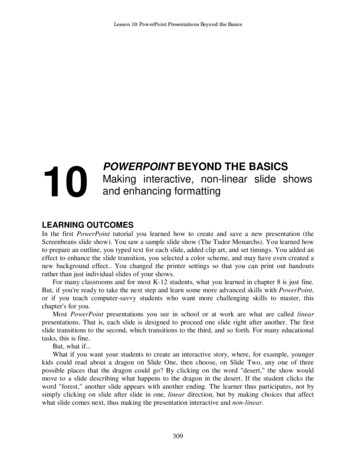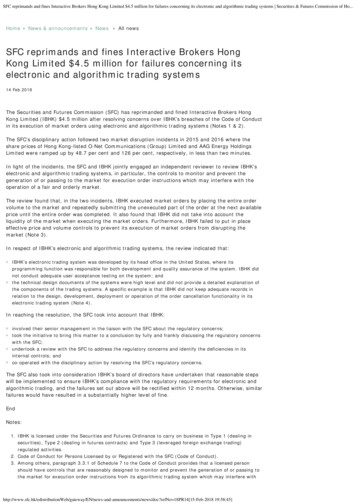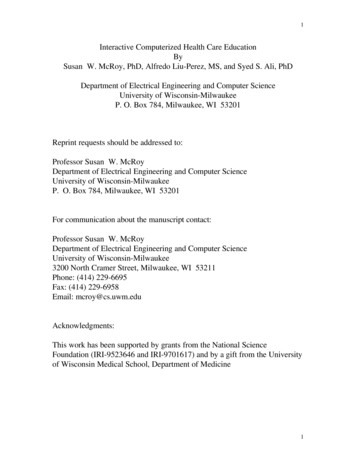
Transcription
1Interactive Computerized Health Care EducationBySusan W. McRoy, PhD, Alfredo Liu-Perez, MS, and Syed S. Ali, PhDDepartment of Electrical Engineering and Computer ScienceUniversity of Wisconsin-MilwaukeeP. O. Box 784, Milwaukee, WI 53201Reprint requests should be addressed to:Professor Susan W. McRoyDepartment of Electrical Engineering and Computer ScienceUniversity of Wisconsin-MilwaukeeP. O. Box 784, Milwaukee, WI 53201For communication about the manuscript contact:Professor Susan W. McRoyDepartment of Electrical Engineering and Computer ScienceUniversity of Wisconsin-Milwaukee3200 North Cramer Street, Milwaukee, WI 53211Phone: (414) 229-6695Fax: (414) 229-6958Email: mcroy@cs.uwm.eduAcknowledgments:This work has been supported by grants from the National ScienceFoundation (IRI-9523646 and IRI-9701617) and by a gift from the Universityof Wisconsin Medical School, Department of Medicine1
2AbstractThe Patient Education and Activation System (PEAS) project aims to prepare people totake a more active role in their health care decisions. In this paper, we describe our workon the Layman Education and Activation Form (LEAF). LEAF is designed to be aninteractive, Internet-based system for collecting a patient’s medical history. It is uniquein that it gives patients access to educational information when it is most pertinent, whilethey are attempting to complete a form. It avoids overwhelming the patient, by onlyproviding the information when it is likely to be relevant. The system avoids askingirrelevant questions or providing irrelevant facts by tailoring the content of the form basedon the patient’s interaction with the system. The system also uses the patient’s answers tosuggest questions that the patient might ask her doctor and provides online resources thatthe patient can browse.Keywords: health education, Internet, medical history form2
3I.IntroductionThe PEAS (Patient Education and Activation System) project aims to prepare people totake a more active role in health care decisions. With the collaboration of the Departmentof Medicine at the University of Wisconsin Medical School (Milwaukee Area ClinicalCampus), the PEAS project group has been developing a coordinated set of computerprograms for educating patients. The project is investigating strategies for helping peopleidentify their health care concerns, learn what actions they can take, and verbalize theirconcerns to health-care professionals. These strategies address the problem of how topresent relevant information efficiently and effectively. This is accomplished by a multimedia computer interface with intelligent tutoring and intelligent discourse processing.One goal of our design has been to create an architecture that would alleviate the problemof misunderstanding and miscommunication between the patient and a computer system.Ultimately, we hope this will also alleviate possible miscommunication between the patientand her physician. Such breakdowns in communication can arise because of differences invocabulary or differences in beliefs about the significance of different states of health.Moreover, errors in understanding can propagate, because people interpret each new facton the basis of their understanding of old facts. To address these concerns, computersystems (and people!) must not ask patients to make choices without allowing them theopportunity to obtain clarification [1]. In addition, systems must avoid overwhelmingtheir users with too much information at once. As in human conversations, computersystems should allow a dialog with users, where each participant takes a turn and thengives the other party a chance to accept it or to ask for clarification. In this way,misunderstandings can be detected and addressed, before communication breaks downcompletely [2].This paper discusses an architecture for patient education that we have developed for theLayman Education and Activation Form (LEAF). LEAF extends the normal activity offilling in a medical form by including educational activities that will help patients to3
4understand medical terminology and various health-care related issues. At any pointduring an interaction with LEAF, patients can access facilities for explaining theterminology of the form (Definitions) and for learning about topics that they might wantto discuss with their doctor (Dialogue). (See Figure 1.) Unlike a hypertext-based system,which presents the same information to everyone, LEAF is interactive and tailors itsinteraction with each patient. It does this by using the information that the patient providesabout herself.For example, suppose that a patient has indicated that she is female, childless, and has afamily history of heart disease. LEAF will dynamically filter irrelevant parts of the medicalhistory form, such as those related to breast feeding. (This customization is importantbecause irrelevant parts of the form are especially likely to contain terminology that isunfamiliar or confusing.) If asked for advice (via Dialogue), LEAF will offer tailoredinformation about prevention and treatment strategies for heart disease and suggestquestions for the patient to ask the doctor. Similarly, if asked for a medical definition,LEAF constructs a customized definition, based on the health history given by the patient.Figure 1: LEAF’s Interface4
5A prototype implementation of LEAF has been built using the JAVA programminglanguage, and is publicly available over the World Wide Web.1 This prototypedemonstrates the functionality of LEAF and its ability to tailor the information that itprovides. It also demonstrates the portability of LEAF. Along with the form itself,LEAF provides a short questionnaire that allows users to participate in an informal (andanonymous) evaluation of LEAF. This informal information has given us insight into howreal patients might react to LEAF and where design improvements should be focused. Theobjectives of the prototype are limited in scope (to establish the proof-of-concept). Forexample, the current project does not address the problems of verifying the accuracy ofthe medical information that is provided. Any medical information provided is forillustrative purposes only, and should not be taken to represent the views of any of thePEAS project participants. The LEAF prototype demonstrates the feasibility and costeffectiveness of patient-tailored computerized interfaces to medical information.II.BackgroundA.Motivations for LEAFLEAF aims to help bridge the communication gap that exists between patients and theirdoctors. Patients are being asked to take a more active role in their health care. Patientsmust therefore be prepared for the increasing amount of information that they will receivedescribing their options and possible courses of action. This preparation includes a betterunderstanding of medical terminology. Although the resources available to health careprofessionals may be limited, computers can help by giving people access to medicalinformation outside the doctor’s office and by adapting the presentation of information tosuit the individual’s interests or expertise.To adapt the presentation of medical (or any type of) information to each user, a systemmust have information about the user and must be able to reason about which parts of its1It can be reached by pointing a JAVA-capable network browser tohttp://tigger.cs.uwm.edu/ alp/LEAFV1.1/leaf.html.5
6knowledge apply to a given situation. Ideally, a system will monitor each patient’sinteraction with the system and build a profile (called a user model) of the patient. As thesystem collects this information, it can use it (as well as the current state of the task) tomodify the questions that it asks and to customize the educational materials that itpresents. For example, it may choose to elaborate the core definition of a concept withspecific information relevant to a health condition that the patient has. This customizationis facilitated by organizing the knowledge base into small units of text that are indexed byfacts about the patient or goals that the patient might have. LEAF’s design provides thistype of flexibility.In designing LEAF, we considered previous methods for collecting medical histories frompatients and presenting educational materials to them. The results of our investigationsupported the need for a system such as LEAF and motivated some additional designconstraints that have been incorporated into the prototype. In the remainder of thissection, we consider some of the lessons learned from prior work. We then will discussthe architecture that has been developed.B.Traditional Medical History FormsFor reasons of generality, typical medical history forms contain questions and sections thatmight be irrelevant to any particular patient. They can also be confusing if they areworded awkwardly or contain medical terminology that is unfamiliar to patients. At thestart of this project, we evaluated a number of such forms. We found questions about thehealth of the patient's spouse, which are irrelevant if the patient is single. We foundsections that were intended “for administrative use only”. We found potentiallyambiguous questions, such as one that asked patients “To what extent are youexperiencing difficulty in the area of:” and presented “apathy, lack or interest in things” asan area. Our evaluator found this confusing, because he felt that he could either respond“no difficulty”, because he never feels apathetic, or he could respond “no difficulty”,because he found it easy to be apathetic. (This confusion is especially easy for non-nativespeakers of English.) Finally, none of the medical forms that we examined provided6
7explanations of the diseases or medical terms used, relying on the strategy that if a patienthas not heard of a disease then she has not had it. However, this is not a good assumptionfor non-native speakers. Moreover, even native speakers may confuse terms that soundalike, such as “constipation” and “obstipation”.C.Computerized Medical FormsComputer programs for collecting patients’ medical history offer the possibility ofsuppressing parts of the form that are unnecessary for patients and for includinginformation that will help patients respond to the questions more accurately. Researchersand clinicians have been experimenting with computerized medical forms since the 1960’s[3-7]. This and subsequent work confirms that medical interviewing by computer can be asreliable as the traditional medical form and that patients will enjoy using it.For example, HealthQuiz is a computer program, developed by the Clinical PracticeEnhancement Project (CPEP), that gathers health-risk data from patients and providesfeedback to both the patient and physician concerning guideline-based suggestions [8,9].These suggestions include possible immunizations or diagnostic tests. In experiments withHealthQuiz, 89% of patients found the computer enjoyable to use and 85% consideredHealthQuiz important to their care. Previous studies by CPEP examined the reliability ofdifferent methods for gathering various types of health information from patients. Theyfound that consistent preventive care information can be obtained when patients use acomputer. In addition, patients were more likely to be candid about risky health behaviorswhen communicating with a computer than with a human interviewer. As in LEAF,HealthQuiz filters questions on the basis of responses to earlier ones. Unlike LEAF,however, it does not support questions from patients about the terminology that it uses.D.Customized Medical ExplanationsAnother potential benefit of computerization of medical history forms and educationalmaterials is the possibility of customizing the content of these materials to individualpatients. Several studies have shown that customized information is more effective thangeneric information. For example, in a study targeting smoking cessation, 30.7% of7
8patients who received tailored health letters reported quitting after six months versus 7.1%in a control group (who received a generic health letter or no information)[10]. In asimilar study targeting nutrition, total fat intake in the tailored group decreased 23%, butby only 9% in the non-tailored group [11]. The primary difficulty is in automating thecustomization process. Here we discuss three systems that have shown that automaticcustomization is possible and effective.Migraineur is a system that provides customized information to patients suffering fromchronic or acute migraine headaches [12]. It consists of an interactive history-takingmodule and an intelligent explanation module. The history-taking module collectsinformation from patients prior to each visit, builds a user model, and summarizes thepatient’s status for their physicians. The intelligent explanation module produces aninteractive information sheet containing explanations in everyday language that aretailored to individual patients, and responds intelligently to follow-up questions abouttopics covered in the information sheet. This information sheet contains generic text that ispresented to all patients, customized text that is presented depending on an analysis of theuser model, and text that, when selected, will show the patients questions that they mightask about the words in that context. The information presented depends on the discoursehistory. As a result, it can avoid repeating the same response, even if the patient asks thesame question more than once.The most important difference between Migraineur and LEAF is that LEAF will providecustomized information while its model of the patient is incomplete, whereas Migraineurcan only do so after knowledge acquisition is finished. This requires motivated users whoare willing to provide a history prior to being helped. Also, Migraineur’s knowledgeacquisition component does not allow the user to ask for medical definitions or for helpabout the form while the patient is still working on it. Migraineur’s ability to track thediscourse history is unique. (This ability is part of the design for LEAF, but it is not part ofthe current prototype.)8
9HealthDoc uses the patient’s medical information, physical characteristics, and medicaldiagnosis to create a document with medical advice tailored to the user [13]. HealthDocdiffers from LEAF in that it is intended to be used by health-care professionals (rather thanpatients) and, like Migrainuer, it does not integrate the task of acquiring knowledge aboutthe patient with the task of generating educational materials.The work of Jimison et al., like Migraineur and HealthDoc, uses a model of the patient togenerate customized educational materials [14]. These materials explain therapy decisionsin terms of the patient’s own condition, medical history, and lifestyle (sedentary vs.active). The system chooses to include or omit therapy explanations depending on thecontents of the patient model. It does not support questions about the explanations that itprovides.E.Systems to be Used at HomeOne goal of LEAF is to prepare patients for subsequent discussions with a health careprofessional. Ideally such a system should be usable by people over the Internet, withoutany outside assistance. The feasibility of this idea is demonstrated by CHESS(Comprehensive Health Enhancement Support System), a system that people can accessfrom their home[15,16]. CHESS provides access to a variety of services, including acompilation of answers to commonly asked questions; a dictionary of health-related terms;a database of articles, brochures, and pamphlets; a tutorial to show users what health andsocial services are available to them; a database of real-life accounts of people coping withhealth crises; facilities for anonymously contacting health-care experts (Ask an Expert) ormembers of appropriate support group (Discussion Group); and programs to help usersassess their lifestyle, think through hard decisions, and develop a plan of action toimplement their decisions.The primary difference between the design of LEAF and the design of CHESS is that, inCHESS, each component is separate from the rest, so that, for example, a person who is9
10using the assessment tool could not look up a word in the dictionary without leaving theassessment program. Also, CHESS does not build any model of its users or theirinteraction with the system, providing the same information to everyone. Moreover, toolsthat collect information about the user (e.g. to perform a risk assessment) cannot makethis information available to other components. As a result, users of CHESS tend toconfine themselves to those components that are personalized and dynamic (Ask anExpert, Discussion Group), but not wholly automated.III.Design Objectives for LEAFLEAF combines three tasks: collecting medical information about patients, providinginformation about the vocabulary and use of the form, and directing patients to additionaleducational materials that might be of interest. We anticipate that such a system would beused by a person who is waiting to see a physician or who is at home considering a visit tothe doctor. Such a person will not always know what they do not know or what they willneed to know to understand the choices that a physician might ask them to make.LEAF has been designed to minimize misunderstandings and to help patients reach themost relevant information efficiently. The design supports these goals by allowingseparate tasks to share information about what the patient is doing and what facts thepatient has already told the system. Wherever possible, the system suppresses irrelevantquestions and information. It also allows users to switch between tasks easily withoutcausing the system to “forget” what it has been told. For example, the patient will haveaccess to definitions of medical terminology, links to online resources, and instructions forfilling out the form, while the patient is working on the form. Moreover, the informationprovided by these services is tailored according to which parts of the form the patient hascompleted or is currently working on.10
11IV.System DescriptionA.The Implementation PlatformThis section describes a prototype implementation of the Layman Education andActivation Form (LEAF). This implementation achieves the design that we havediscussed. In addition, the implementation has been developed to maximize itsportability---we want LEAF to be usable from a variety of locations using a variety ofcomputer hardware. The solution that we have selected is to build a system that could berun using free and widely available programs for accessing the Internet, such asNetscape’s Navigator or Microsoft’s Internet Explorer. Such a program can be used toaccess files at a remote location on the Internet or can be used on a standalone machinethat is running another program called a “server”.For reasons of network security, applications run from network browsing programscannot write files on the local machine. Moreover, for portability reasons, we do not wantfiles to be written on the remote machine either. LEAF addresses both of these concernsby generating new screens dynamically and communicating this information to theinterface program directly.The implementation of LEAF is composed of a number of programs written in JAVA, C,and the Hypertext Markup Language (HTML). JAVA is an object-oriented programminglanguage that is well suited to building user interfaces because of its portability and theavailability of ready-made code for implementing forms. The core medical history formpresented by LEAF is a JAVA program that can be run by any “JAVA-aware” browser.HTML is a language for specifying the format of a document and for creating linksbetween documents. LEAF uses it in the presentation of customized medical definitionsand context-sensitive help. C is a general-purpose programming language; it is used towrite CGI (“Common Gateway Interface”) scripts that can b
Susan W. McRoy, PhD, Alfredo Liu-Perez, MS, and Syed S. Ali, PhD Department of Electrical Engineering and Computer Science University of Wisconsin-Milwaukee P. O. Box 784, Milwaukee, WI 53201 Reprint requests should be addressed to: Professor Susan W. McRoy
